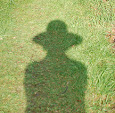We
spent some time exploring the Angus countryside. Near Forfar, at a
place called Dunnichen. we found The Dunnichen
Stone. It is a Pictish Stone with carved symbols on it.
Wikipedia states the symbols are: flower, double disc and z rod and a mirror and comb
M-m-m-m... I took the circular shape with lines above it to be an eye.
It reminded me of carvings on totem poles of the Indian bands of the Pacific Northwest.
This shows carvings by Haida Indians in the Queen Charlotte Islands, British Columbia. [Photo: Wikipedia]
On
the mainland of British Columbia other tribes of Indians had similar
artwork. This box from UBC Anthropology Museum reminded me of the
artwork on a carved ornamental paddle that my mother had from the days
when she lived with her mother, father and siblings in Port Simpson,
north of Prince Rupert. Her father was a minister there. The Indian
band were Tsimshian and this is an example of their artwork.
[Photo: Wikipedia]
[Photo: Wikipedia]
[Carved
paddle with similar artwork was about 10 inches long. We gave it to the
museum in Victoria; never took a photo of it ... 'twas the days before
iPhones!]
I wondered if the Easter Island stones had anything similar to the Pictish stones.
I had only ever read about the 'heads' on Easter Island. They certainly did not have carved eyes in the manner of carved symbols. These eyes are rather like 'hollows' in the stone surface.
However, when searching the internet for the topic I found:
(a) excavation has shown that these heads are part of a body which is buried
and ....
(b) they have carved symbols on the back.
Photos are from UCLA archaeology publication photos © Easter Island Statue Project
But are there any eyes?.....?
I ran across this photo of 'Magnetic Stones, Ahu Te Pito Kura, Easter Island'
which
... again ... reminded me of the carved stones found in Scotland (in a
variety of locations) which continue to be a mystery as to their
function.
Photo above is mine: Hunterian Museum, Glasgow University.














No comments:
Post a Comment